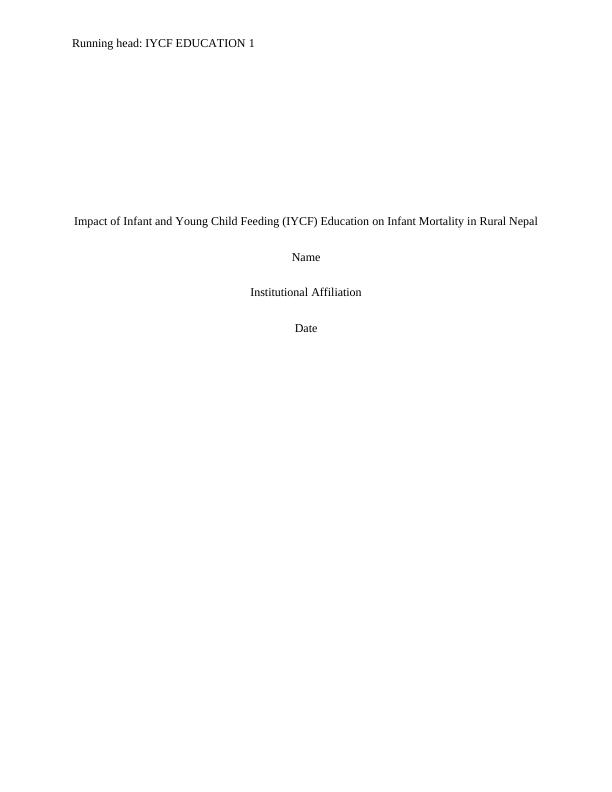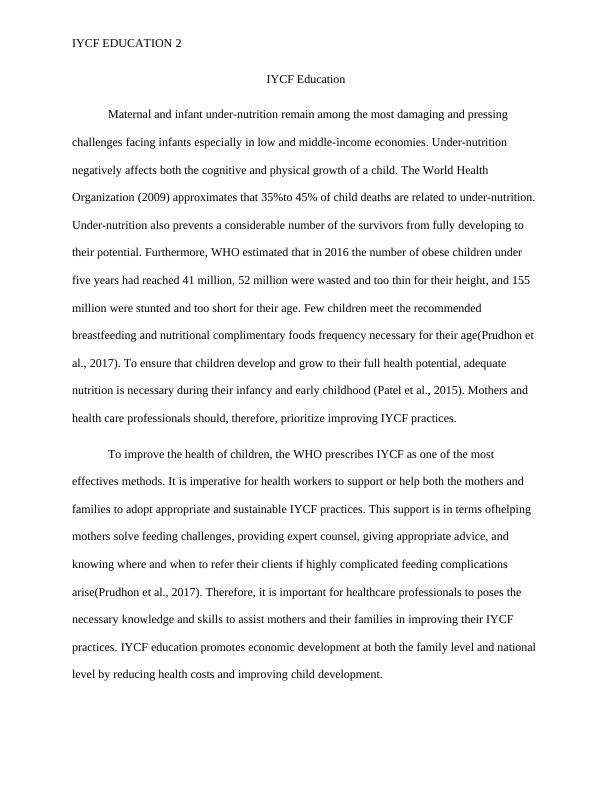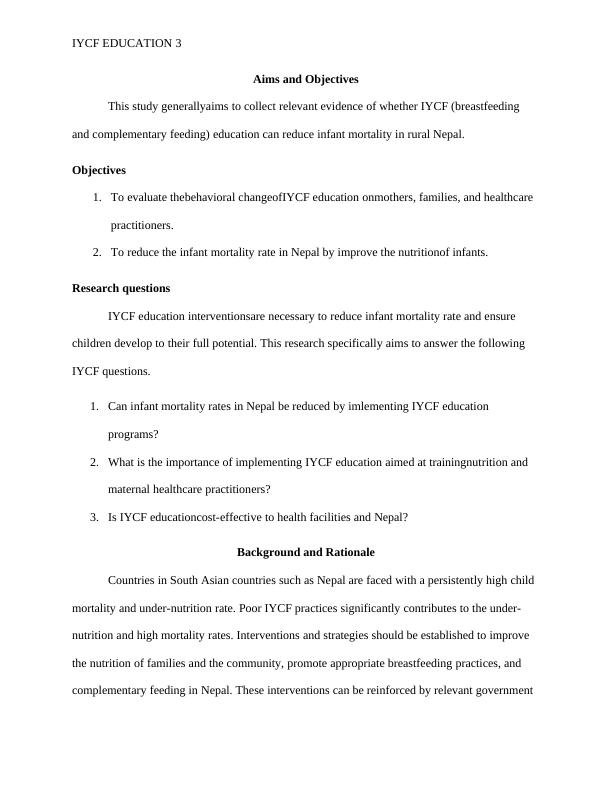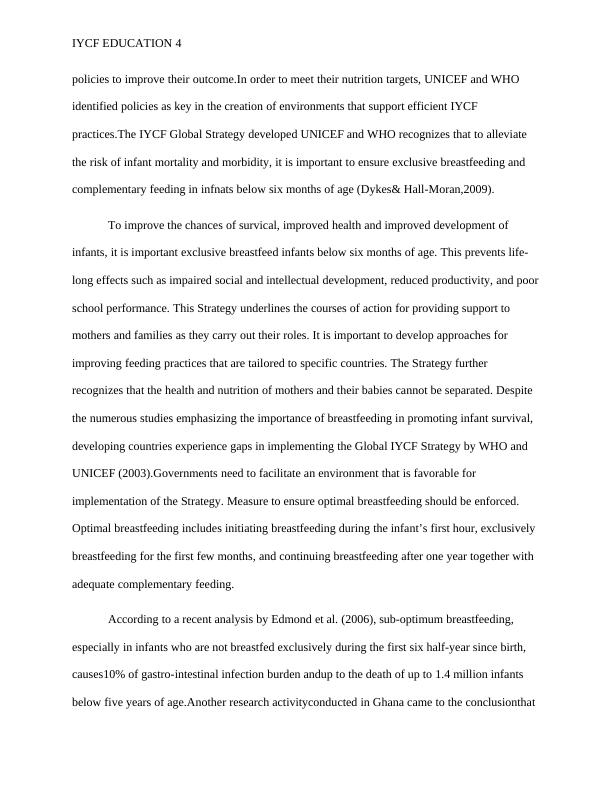Impact of Infant and Young Child Feeding (IYCF)
Added on 2020-03-16
18 Pages4550 Words50 Views
Running head: IYCF EDUCATION 1
Impact of Infant and Young Child Feeding (IYCF) Education on Infant Mortality in Rural Nepal
Name
Institutional Affiliation
Date
Impact of Infant and Young Child Feeding (IYCF) Education on Infant Mortality in Rural Nepal
Name
Institutional Affiliation
Date

IYCF EDUCATION 2
IYCF Education
Maternal and infant under-nutrition remain among the most damaging and pressing
challenges facing infants especially in low and middle-income economies. Under-nutrition
negatively affects both the cognitive and physical growth of a child. The World Health
Organization (2009) approximates that 35%to 45% of child deaths are related to under-nutrition.
Under-nutrition also prevents a considerable number of the survivors from fully developing to
their potential. Furthermore, WHO estimated that in 2016 the number of obese children under
five years had reached 41 million, 52 million were wasted and too thin for their height, and 155
million were stunted and too short for their age. Few children meet the recommended
breastfeeding and nutritional complimentary foods frequency necessary for their age(Prudhon et
al., 2017). To ensure that children develop and grow to their full health potential, adequate
nutrition is necessary during their infancy and early childhood (Patel et al., 2015). Mothers and
health care professionals should, therefore, prioritize improving IYCF practices.
To improve the health of children, the WHO prescribes IYCF as one of the most
effectives methods. It is imperative for health workers to support or help both the mothers and
families to adopt appropriate and sustainable IYCF practices. This support is in terms ofhelping
mothers solve feeding challenges, providing expert counsel, giving appropriate advice, and
knowing where and when to refer their clients if highly complicated feeding complications
arise(Prudhon et al., 2017). Therefore, it is important for healthcare professionals to poses the
necessary knowledge and skills to assist mothers and their families in improving their IYCF
practices. IYCF education promotes economic development at both the family level and national
level by reducing health costs and improving child development.
IYCF Education
Maternal and infant under-nutrition remain among the most damaging and pressing
challenges facing infants especially in low and middle-income economies. Under-nutrition
negatively affects both the cognitive and physical growth of a child. The World Health
Organization (2009) approximates that 35%to 45% of child deaths are related to under-nutrition.
Under-nutrition also prevents a considerable number of the survivors from fully developing to
their potential. Furthermore, WHO estimated that in 2016 the number of obese children under
five years had reached 41 million, 52 million were wasted and too thin for their height, and 155
million were stunted and too short for their age. Few children meet the recommended
breastfeeding and nutritional complimentary foods frequency necessary for their age(Prudhon et
al., 2017). To ensure that children develop and grow to their full health potential, adequate
nutrition is necessary during their infancy and early childhood (Patel et al., 2015). Mothers and
health care professionals should, therefore, prioritize improving IYCF practices.
To improve the health of children, the WHO prescribes IYCF as one of the most
effectives methods. It is imperative for health workers to support or help both the mothers and
families to adopt appropriate and sustainable IYCF practices. This support is in terms ofhelping
mothers solve feeding challenges, providing expert counsel, giving appropriate advice, and
knowing where and when to refer their clients if highly complicated feeding complications
arise(Prudhon et al., 2017). Therefore, it is important for healthcare professionals to poses the
necessary knowledge and skills to assist mothers and their families in improving their IYCF
practices. IYCF education promotes economic development at both the family level and national
level by reducing health costs and improving child development.

IYCF EDUCATION 3
Aims and Objectives
This study generallyaims to collect relevant evidence of whether IYCF (breastfeeding
and complementary feeding) education can reduce infant mortality in rural Nepal.
Objectives
1. To evaluate thebehavioral changeofIYCF education onmothers, families, and healthcare
practitioners.
2. To reduce the infant mortality rate in Nepal by improve the nutritionof infants.
Research questions
IYCF education interventionsare necessary to reduce infant mortality rate and ensure
children develop to their full potential. This research specifically aims to answer the following
IYCF questions.
1. Can infant mortality rates in Nepal be reduced by imlementing IYCF education
programs?
2. What is the importance of implementing IYCF education aimed at trainingnutrition and
maternal healthcare practitioners?
3. Is IYCF educationcost-effective to health facilities and Nepal?
Background and Rationale
Countries in South Asian countries such as Nepal are faced with a persistently high child
mortality and under-nutrition rate. Poor IYCF practices significantly contributes to the under-
nutrition and high mortality rates. Interventions and strategies should be established to improve
the nutrition of families and the community, promote appropriate breastfeeding practices, and
complementary feeding in Nepal. These interventions can be reinforced by relevant government
Aims and Objectives
This study generallyaims to collect relevant evidence of whether IYCF (breastfeeding
and complementary feeding) education can reduce infant mortality in rural Nepal.
Objectives
1. To evaluate thebehavioral changeofIYCF education onmothers, families, and healthcare
practitioners.
2. To reduce the infant mortality rate in Nepal by improve the nutritionof infants.
Research questions
IYCF education interventionsare necessary to reduce infant mortality rate and ensure
children develop to their full potential. This research specifically aims to answer the following
IYCF questions.
1. Can infant mortality rates in Nepal be reduced by imlementing IYCF education
programs?
2. What is the importance of implementing IYCF education aimed at trainingnutrition and
maternal healthcare practitioners?
3. Is IYCF educationcost-effective to health facilities and Nepal?
Background and Rationale
Countries in South Asian countries such as Nepal are faced with a persistently high child
mortality and under-nutrition rate. Poor IYCF practices significantly contributes to the under-
nutrition and high mortality rates. Interventions and strategies should be established to improve
the nutrition of families and the community, promote appropriate breastfeeding practices, and
complementary feeding in Nepal. These interventions can be reinforced by relevant government

IYCF EDUCATION 4
policies to improve their outcome.In order to meet their nutrition targets, UNICEF and WHO
identified policies as key in the creation of environments that support efficient IYCF
practices.The IYCF Global Strategy developed UNICEF and WHO recognizes that to alleviate
the risk of infant mortality and morbidity, it is important to ensure exclusive breastfeeding and
complementary feeding in infnats below six months of age (Dykes& Hall-Moran,2009).
To improve the chances of survical, improved health and improved development of
infants, it is important exclusive breastfeed infants below six months of age. This prevents life-
long effects such as impaired social and intellectual development, reduced productivity, and poor
school performance. This Strategy underlines the courses of action for providing support to
mothers and families as they carry out their roles. It is important to develop approaches for
improving feeding practices that are tailored to specific countries. The Strategy further
recognizes that the health and nutrition of mothers and their babies cannot be separated. Despite
the numerous studies emphasizing the importance of breastfeeding in promoting infant survival,
developing countries experience gaps in implementing the Global IYCF Strategy by WHO and
UNICEF (2003).Governments need to facilitate an environment that is favorable for
implementation of the Strategy. Measure to ensure optimal breastfeeding should be enforced.
Optimal breastfeeding includes initiating breastfeeding during the infant’s first hour, exclusively
breastfeeding for the first few months, and continuing breastfeeding after one year together with
adequate complementary feeding.
According to a recent analysis by Edmond et al. (2006), sub-optimum breastfeeding,
especially in infants who are not breastfed exclusively during the first six half-year since birth,
causes10% of gastro-intestinal infection burden andup to the death of up to 1.4 million infants
below five years of age.Another research activityconducted in Ghana came to the conclusionthat
policies to improve their outcome.In order to meet their nutrition targets, UNICEF and WHO
identified policies as key in the creation of environments that support efficient IYCF
practices.The IYCF Global Strategy developed UNICEF and WHO recognizes that to alleviate
the risk of infant mortality and morbidity, it is important to ensure exclusive breastfeeding and
complementary feeding in infnats below six months of age (Dykes& Hall-Moran,2009).
To improve the chances of survical, improved health and improved development of
infants, it is important exclusive breastfeed infants below six months of age. This prevents life-
long effects such as impaired social and intellectual development, reduced productivity, and poor
school performance. This Strategy underlines the courses of action for providing support to
mothers and families as they carry out their roles. It is important to develop approaches for
improving feeding practices that are tailored to specific countries. The Strategy further
recognizes that the health and nutrition of mothers and their babies cannot be separated. Despite
the numerous studies emphasizing the importance of breastfeeding in promoting infant survival,
developing countries experience gaps in implementing the Global IYCF Strategy by WHO and
UNICEF (2003).Governments need to facilitate an environment that is favorable for
implementation of the Strategy. Measure to ensure optimal breastfeeding should be enforced.
Optimal breastfeeding includes initiating breastfeeding during the infant’s first hour, exclusively
breastfeeding for the first few months, and continuing breastfeeding after one year together with
adequate complementary feeding.
According to a recent analysis by Edmond et al. (2006), sub-optimum breastfeeding,
especially in infants who are not breastfed exclusively during the first six half-year since birth,
causes10% of gastro-intestinal infection burden andup to the death of up to 1.4 million infants
below five years of age.Another research activityconducted in Ghana came to the conclusionthat

End of preview
Want to access all the pages? Upload your documents or become a member.
Related Documents
Infant and young child feeding education and its impact on infant mortality in rural Nepallg...
|12
|3565
|74
Impact of IYCF Education on Infant Mortality in Aboriginal Population in Australialg...
|11
|3318
|233
Evidence Into Practicelg...
|11
|3186
|67
International Healthcare Leadership: Breastfeeding Program Implementation in Saudi Arabialg...
|22
|6256
|357
The Role of Social Support in Breastfeedinglg...
|19
|4901
|65
Importance of Breastfeeding for Health and Well-being in UKlg...
|5
|1860
|275
